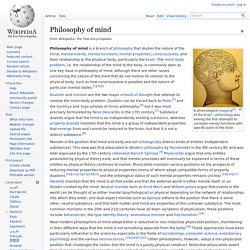

At the Interface - Volume I, Number 1. We already have the ultimate computer interface.

Or, at least one half of it. That interface is what you and I present to the computer: a body that can speak, look, and gesture. What we ordinarily do not have on the other side of the interface--the machine's side-- are the sensors and program intelligence that can capture such outputs from the person, interpret those outputs, and make an appropriate response. Modes and meanings Consider the following scene: Philosophy of mind. A phrenological mapping[1] of the brain – phrenology was among the first attempts to correlate mental functions with specific parts of the brain Philosophy of mind is a branch of philosophy that studies the nature of the mind, mental events, mental functions, mental properties, consciousness, and their relationship to the physical body, particularly the brain.

The mind–body problem, i.e. the relationship of the mind to the body, is commonly seen as one key issue in philosophy of mind, although there are other issues concerning the nature of the mind that do not involve its relation to the physical body, such as how consciousness is possible and the nature of particular mental states.[2][3][4] Mind–body problem[edit] Our perceptual experiences depend on stimuli that arrive at our various sensory organs from the external world, and these stimuli cause changes in our mental states, ultimately causing us to feel a sensation, which may be pleasant or unpleasant.
Arguments for dualism[edit] Solar decathlon counter entropy.
Zooming UI. Borchers.